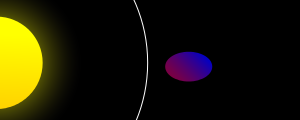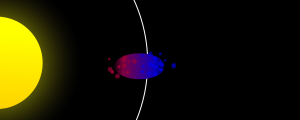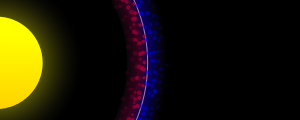Roche limit
 |
 |
 |
 |
 |
In astronomy, the Roche limit refers to the minimum distance that an object can withstand orbiting a massive body, maintaining its structure by its own gravity, without beginning to disintegrate due to tidal forces that generates the larger body. Within the Roche limit, the gravitational force exerted by the central body on the nearest and farthest ends of the satellite exceeds the gravitational force of the satellite, and the satellite may be destroyed by tidal forces. The name Roche limit comes from the French astronomer Édouard Roche, who first proposed this effect and calculated this theoretical limit in 1848.
The Roche limit depends, therefore, on the gravity of the central body but also on the density characteristics of the satellite.
Not to be confused with the Roche lobe, a theoretical concept also proposed by Édouard Roche that describes the limit at which a low-mass object in a system dominated by two larger bodies is captured by one of them.
Some satellites, both natural and artificial, orbit at distances less than the Roche limit, since they maintain their structure by forces other than gravity: the resistance of the material. Among Jupiter's moons, both Adrastea and Metis are examples of natural bodies that maintain their cohesion beyond their Roche limits. However, any object on its surface can be shelled by tidal forces. A body with less cohesion, such as a comet, will be destroyed when it passes through its Roche limit. Comet Shoemaker-Levy 9 passed through Jupiter's Roche boundary in July 1992, breaking up into numerous fragments. In 1994 the remains of the comet impacted on the surface of the planet.
Since within the Roche limit the tidal forces caused by the main body are greater than the force of gravity of the captive object, no body can grow by coalescence of smaller particles within this limit. For example, all planetary rings lie within their Roche limits. These rings could be the remains of the accretion disk that failed to coalesce to form a satellite, or they could be the remains of an object that passed through the Roche boundary and was destroyed by tidal forces.
The Roche limit is defined solely in terms of the forces of gravity, tidal force, and autogravity. In practice, the question of the structural stability of a moon will also depend on its speed of rotation and the centrifugal force coming from its rotation.
Determination of the Roche limit
Rigid bodies
The Roche limit depends on the rigidity of the satellite orbiting the planet. For one, this could be a perfect sphere in which case the Roche limit is
d=R(2ρ ρ Mρ ρ m)13≈ ≈ 1,260R(ρ ρ Mρ ρ m)0.333{displaystyle d=Rleft(2;{frac {rho _{M}{rho _{m}}{m}}right)^{frac {1}{3}}}approx 1,260Rleft({frac {rho _{M}}{rho _{m}}}}{right}{0.333}}}}}}}}{
where:
- R{displaystyle R} is the radius of the main body,
- ρ ρ M{displaystyle rho _{M}} is its density and
- ρ ρ m{displaystyle rho _{m}} It's satellite density.
If the moon has a density greater than twice the density of the planet, as can happen in a rocky satellite orbiting a gas giant, then the Roche limit would be inside the planet itself and would be a magnitude of no relevance.
Deformable bodies
The other limiting case is a satellite capable of deforming without offering any resistance, just as a liquid would. Although the exact calculation cannot be done analytically, a fairly good approximation can be given by means of the following formula:
d≈ ≈ 2,423R(ρ ρ Mρ ρ m)13{displaystyle dapprox 2,423Rleft({frac {rho _{M}}{rho _{m}}}}{right)^{frac {1}{3}}}}}{
Deduction of the formula: rigid bodies
To determine the Roche limit is considered a small mass particle compared to the mass of the other bodies, which we call δ δ m{displaystyle delta m} (in the figure it appears as u) on the surface of a small body (satellite) in the vicinity of a larger body (planet). The particle δ δ m{displaystyle delta m} You will experience two forces, the gravity of the satellite, which makes you stay on your surface, and the gravity of the main planet. Since the satellite is in orbital motion, the result of the gravity exercised by the planet is only the tide force.
The thrust of gravity FG{displaystyle F_{G}} on the small mass particle δ δ m{displaystyle delta m} on the mass satellite m{displaystyle m} and radio r{displaystyle r} can be expressed according to Newton's law of gravitation:
FG=Gmδ δ mr2{displaystyle F_{G}={frac {Gmdelta m}{r^{2}}}}}}
The tide force FT{displaystyle F_{T}} on the mass δ δ m{displaystyle delta m} exercised by the central radio planet R{displaystyle R} and at a distance d{displaystyle d} between the mass centers of both bodies is:
FT=2GMδ δ mrd3{displaystyle F_{T}={frac {2GMdelta mr}{d^{3}}}}}}
The Roche limit is reached when the gravitational pull and the tidal force cancel each other:
FG=FT{displaystyle F_{G}=F_{T}}}
or,
Gmδ δ mr2=2GMδ δ mrd3{displaystyle {frac {Gmdelta m}{r^{2}}}}{{frac {2GMdelta mr}{d^{3}}}}}}}
expression that allows to calculate the Roche limit, d{displaystyle d}:
d=r(2M/m)13{displaystyle d=rleft(2M/mright)^{frac {1}{3}}}}}
However, it is convenient to express this equation in an alternative form that does not depend on the radius of the satellite, so we rewrite this expression in terms of the densities of the planet and the satellite.
The mass M{displaystyle M} of a radio dial R{displaystyle R} is:
M=4π π ρ ρ MR33{displaystyle M={frac {4pi rho _{M}R^{3}{3}}{3}}}}}}
And analogously for the second body:
m=4π π ρ ρ mr33{displaystyle m={frac {4pi rho _{m}r^{3}{3}}{3}}}}}}.
Substituting both masses into the Roche limit equation gives:
d=r(2ρ ρ MR3/ρ ρ mr3)13{displaystyle d=rleft(2rho _{M}R^{3}/rho _{m}r^{3}{3}right)^{frac {1}{3}}}{3}}}}
which can be simplified into the usual expression for the Roche limit.
d=R(2ρ ρ Mρ ρ m)13{displaystyle d=Rleft(2;{frac {rho _{M}{rho _{m}}}{m}}{right)^{frac {1}{3}}}}}}}{
Deduction of the formula: non-spherical deformable bodies
A somewhat more precise expression for the Roche limit should take into account the deformations produced in the satellite by tidal forces. In these cases the satellite would be deformed into an elliptical spheroid. The exact calculation cannot be done analytically. Historically Roche derived a numerical approximation for this problem.
d≈ ≈ 2,44R(ρ ρ Mρ ρ m)13{displaystyle dapprox 2,44Rleft({frac {rho _{M}{M}{rho _{m}}}}}{right)^{frac {1}{3}}}}}}}{
With the help of computers it is easy to find a better approximation
d≈ ≈ 2,423R(ρ ρ Mρ ρ m)13((1+m3M)+c3R(1+mM)1− − cR)13{displaystyle dapprox 2,423Rleft({frac {rho _{M}}{rho _{m}}}}{right){frac {1}{3}{3frac}{1⁄4}{frac}{(1+{frac}{m}{3}}{1⁄2}{1⁄2}{1⁄2}}{1⁄2}}}{1⁄2}}}{1⁄4}}}}{1⁄4}{1⁄4}{c(1⁄4}{c(1⁄2}}}}}}}}}{1⁄4}{1⁄4}{c(1⁄2}{c(1⁄2}{c(1⁄2}{c(1⁄2}{c(1st}}}}}}}}}}}}}{c(1⁄2}{c(1⁄4}{c(1⁄2}{c(1⁄2}}}}{
where c/R{displaystyle c/R} is a factor that expresses the degree of deformation of the main body.
Roche's limit in solar system examples
The table below shows the average density and equatorial radii of different objects in the solar system.
| Body | Density (kg/m3) | Radio (m) |
|---|---|---|
| Sun | 1.400 | 695,000.000 |
| Jupiter | 1.330 | 71,500,000 |
| Earth | 5.515 | 6,376,500 |
| Moon | 3.340 | 1,737,400 |
With these data, the Roche limit for rigid bodies and deformable bodies can be easily calculated. The average density of comets can be considered around 500 kg/m³.
The true Roche limit depends on the flexibility of the satellite, so it will be somewhere in the middle between the limits calculated for the rigid body and the perfectly deformable body calculated above. If the larger central body has a density less than half that of the orbiting body, the Roche limit is reached below the radius of the planet and the satellite cannot reach that limit. This is the case, for example, of the Roche limit for the Sun-Earth system. The following table gives the Roche limits expressed in meters and in central body radii.
| Body | Satellite | Limit of Roche (rigid) | Limit of Roche (not rigid) | ||
|---|---|---|---|---|---|
| Distance (m) | Radio | Distance (m) | Radio | ||
| Earth | Moon | 9.495.665 | 1.49 | 18.261.459 | 2.86 |
| Earth | Comet | 17.883.432 | 2.80 | 34.392.279 | 5,39 |
| Sun | Earth | 554.441.389 | 0.80 | 1.066.266.402 | 1.53 |
| Sun | Comet | 1.234.186.562 | 1.78 | 2.373.509.071 | 3,42 |
It is interesting to consider how close or far different moons in the solar system are from their Roche boundaries. The following table gives the orbital radius of each satellite divided by its Roche limits in both the rigid and flexible body cases. In the cases of the giant planets only the smallest inner satellites have been considered. Major moons like Io on Jupiter or Titan on Saturn are at distances well beyond their Roche limits.
| Central body | Satellite | Radio Orbital: Limit of Roche | |
|---|---|---|---|
| (Chuckles) | (No laugh) | ||
| Sun | Mercury | 104:1 | 54:1 |
| Earth | Moon | 41:1 | 21:1 |
| Mars | Fobos | 171% | 89% |
| We | 456% | 237% | |
| Jupiter | Metis | 191% | 99 per cent |
| Adrastea | 192% | 100% | |
| Amaltea | 178% | 93% | |
| Tebe | 331% | 172% | |
| Saturn | Pan | 177% | 92% |
| Atlas | 182% | 95% | |
| Prometheus | 185% | 96% | |
| Pandora | 188% | 98% | |
| Epimetheus | 198% | 103% | |
| Uranus | Cordelia | 155% | 81% |
| Ofelia | 168% | 87% | |
| Bianca | 184% | 96% | |
| Crésida | 193% | 100% | |
| Neptune | Náyade | 144% | 75% |
| Talasa | 149% | 78% | |
| Despina | 157% | 82% | |
| Galatea | 184% | 96% | |
| Larisa | 219% | 114% | |
| Pluto | Caronte | 13:1 | 6.8:1 |
It is interesting to note how the minor satellites of the giant planets are close to their Roche limits, their structure being maintained by internal cohesive forces and not solely by their gravity. In the region dominated by rings, such as Saturn's rings, it is impossible to group the particles into larger bodies because they would be disintegrated by the effects of the tidal force. These satellites probably originated in regions farther away from the giant planets and their orbits were later modified perhaps by the gravitational interaction of the other satellites. Alternatively, perhaps they were formed in regions close to their current positions when the central planets were still in full formation and of lower mass. This second scenario is however less likely.
Contenido relacionado
Astrophysics
Category:Jupiter
(176) Iduna























